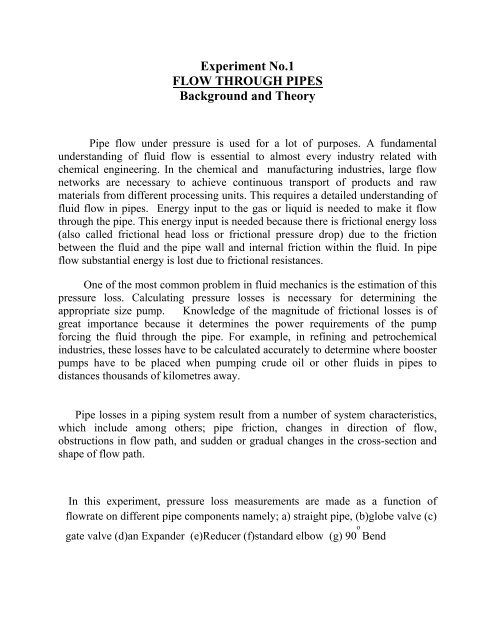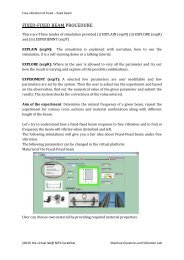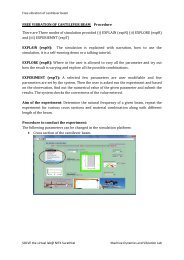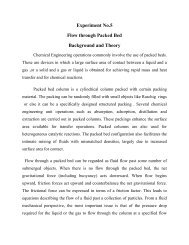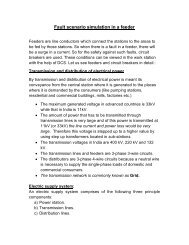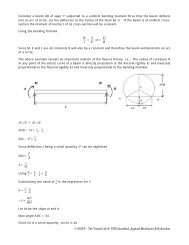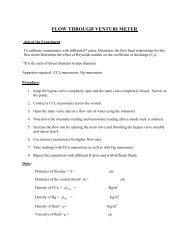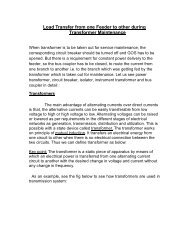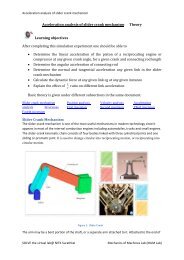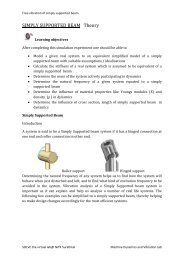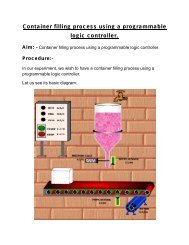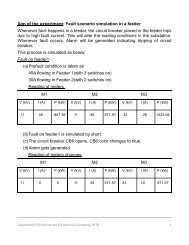Experiment No.1 FLOW THROUGH PIPES Background and Theory
Experiment No.1 FLOW THROUGH PIPES Background and Theory
Experiment No.1 FLOW THROUGH PIPES Background and Theory
You also want an ePaper? Increase the reach of your titles
YUMPU automatically turns print PDFs into web optimized ePapers that Google loves.
series of liquid cylinders in the pipe, where the innermost parts flow the fastest,<strong>and</strong> the cylinder touching the pipe isn't moving at all.Turbulent flowIn turbulent flow, the fluid moves erratically in the form of cross currents <strong>and</strong>eddies. Turbulent flow happens in general at high flow rates <strong>and</strong> with larger pipes.Transitional flowTransitional flow is a mixture of laminar <strong>and</strong> turbulent flow, with turbulence in thecenter of the pipe, <strong>and</strong> laminar flow near the edges.Each of these flows behave in different manners in terms of their frictionalenergy loss while flowing, <strong>and</strong> have different equations that predict theirbehavior.Reynolds studied the conditions under which one type of flow changesinto the other <strong>and</strong> found that the critical velocity ,at which laminar flow changesinto turbulent flow ,depends on four quantities: the diameter of the tube, viscosity,density <strong>and</strong> average velocity of the liquid. He found that these four factors can becombined into one group <strong>and</strong> that the change in kind of flow occurs at a definitevalue of the group. The grouping of the variables so found was Reynolds Number.Turbulent or laminar flow is determined by Reynolds Number.Osbourne Reynolds (1842-1912)
The Reynolds number expresses the ratio of inertial (resistant to change ormotion) forces to viscous forces.DρVinertia forceNRe= = μ viscous force(1)Where D is the diameter of the pipeρ is the density of fluidV is the average velocity of the fluidµ is the viscosity of fluid.The Reynolds number can be written in terms of kinematic viscosity ( η)η= dynamic viscosity / density= (2)(3)The Reynolds number is important in analyzing any type of flow when there issubstantial velocity gradient (i.e. shear.) It indicates the relative significance of theviscous effect compared to the inertia effect.The flow is• laminar when < 2100• transient when 2100 < < 4000• turbulent when 4000
At laminar region,viscous forces are dominant as compared to inertial forces.Under laminar flow condition the pressure drop per unit length is proportional tothe velocity. At transition region, the experimental results are not reproducible.Finally, at turbulent region, inertial forces are dominant. For turbulent flow, thepressure drop becomes proportional to the velocity raised to a power of 2.Relationship Between Frictional Head Loss <strong>and</strong>Frictional Pressure DropThe energy loss in pipe flow due to friction can be expressed as a pressuredrop instead of as a head loss. Chemical <strong>and</strong> mechanical engineers often work withpressure drop, whereas civil engineers usually work with head loss. Therelationship between frictional head loss <strong>and</strong> frictional pressure drop is simply:(-ΔP) f = ρgh fs (4)where:(-ΔP) f = frictional pressure drop ,h fs = frictional head loss due to skin friction,ρ = fluid density,g = acceleration due to gravityHead Loss due to skin friction (h fs ) can be related to wall shear.∆P) fs /ρ (5)Where is the shear stress at the wall of the pipe, L is the length of the pipe <strong>and</strong>is the pressure drop due to frictional losses.is not conveniently determined so the dimensionless friction factor is introducedinto the equations.
The Friction Factor It is denoted by f <strong>and</strong> defined as the ratio of the wall shearstress to the product of the velocity head (V 2 /2) <strong>and</strong> density.fτw≡2ρV2wall shear stress=density ∗velocityhead(6)hfs=−( ΔP)ρgf= 4 f⎛⎜⎝2L ⎞ V ⎟D ⎠ 2g(7)Where f is the Fannings friction factor• Only need L, D, V <strong>and</strong> f to get friction loss• Valid for both laminar <strong>and</strong> turbulent flow• Valid for Newtonian <strong>and</strong> Non-Newtonian fluidsCorrelations were made between the fanning friction factor <strong>and</strong> the Reynolds number for bothlaminar <strong>and</strong> turbulent flow in a variety of pipes.For laminar flow, first principles can be used to develop a relation betweenReynolds number <strong>and</strong> friction factor. The Hagen-Poiseuille equation relates thefrictional pressure drop to fluid velocity, viscosity, <strong>and</strong> pipe dimension:= (8)Equating the pressure drop due to friction in the Hagen-Poiseuille equation givenby Eq.8, with the overall pressure drop across the pipe, <strong>and</strong> combining with theFanning equation given by Eq.7, results in relation for laminar flow as
(9)A first principle analysis can not be used to develop a relation between frictionfactor <strong>and</strong> Reynolds numbers for turbulent flow. A variety of empiricalcorrelations exist for turbulent flow in smooth pipes.Blasius equations :f Blasius=0N. 079Re0 . 25(10)The above correlation is valid forThe Blasius equation is purely an empirical equation <strong>and</strong> has no theoretical basis,but it is a convenient form for application. The entire turbulent region can berepresented by the von Kármán-Nikuradse equation:-0.4 (11)for Re > 4000, turbulentIt has long been known that in turbulent flow a rough pipe leads to a largerfriction factor for a given Reynolds number than a smooth pipe does. If a roughpipe is smoothed , the friction factor is reduced. When further smoothing bringsabout no further reduction in friction factor for a given Reynolds number,the tubeis said to be hydraulically smooth.In turbulent flow, the friction factor, f depends upon the Reynolds number <strong>and</strong>on the relative roughness of the pipe, k/D, where, k is the roughnessparameter(average roughness height of the pipe) <strong>and</strong> D is the inner diameter of thepipe. . The general behavior of turbulent pipe flow in the presence of surfaceroughness is well established. When k is very small compared to the pipe diameter


